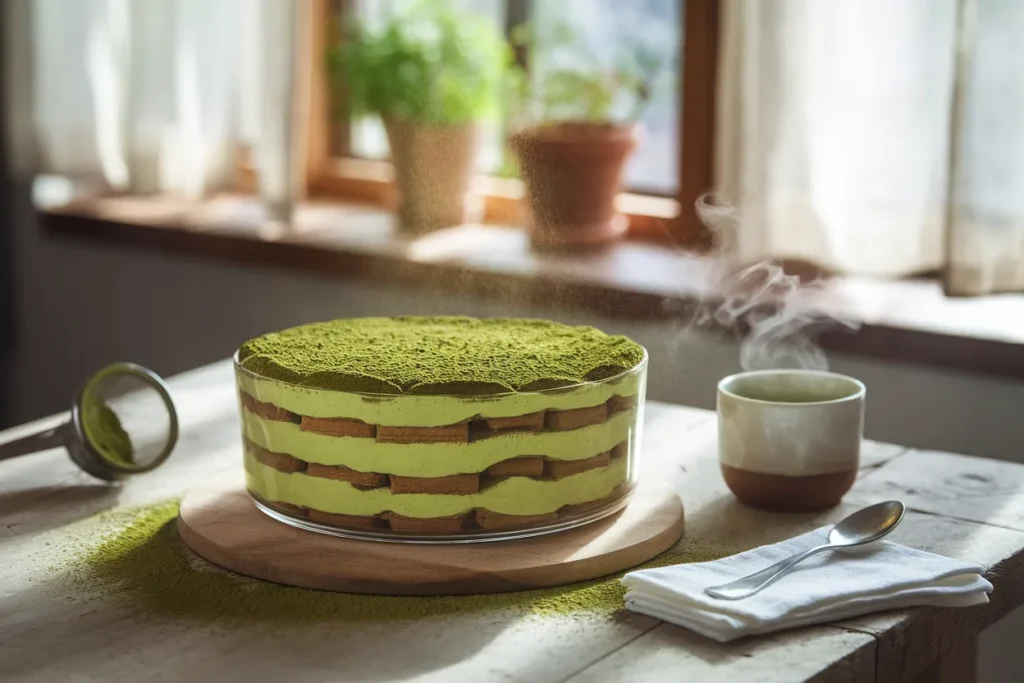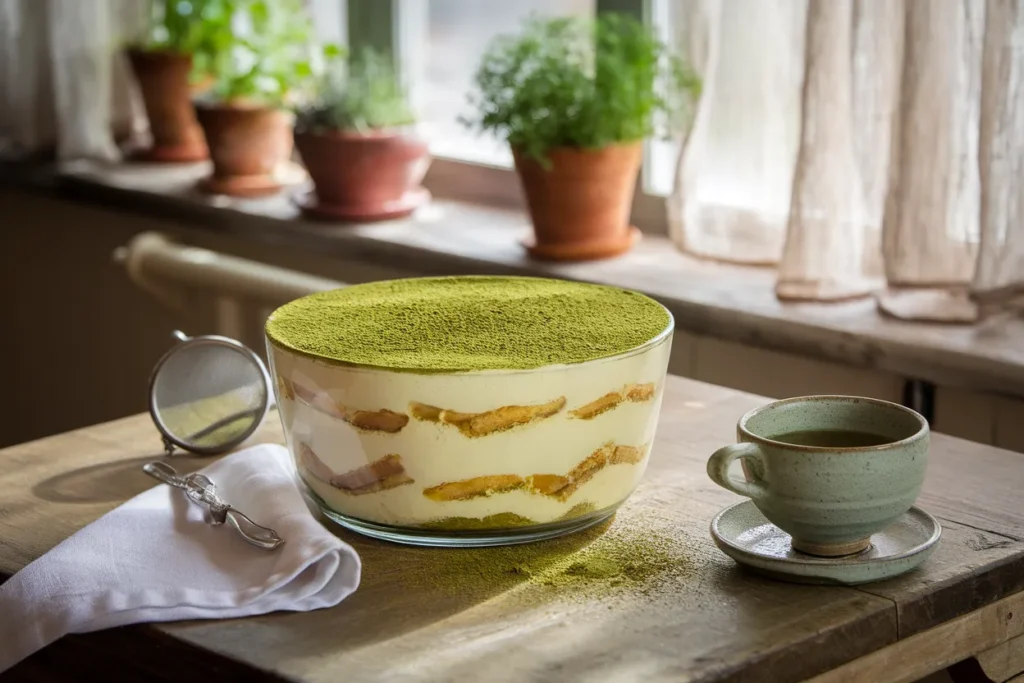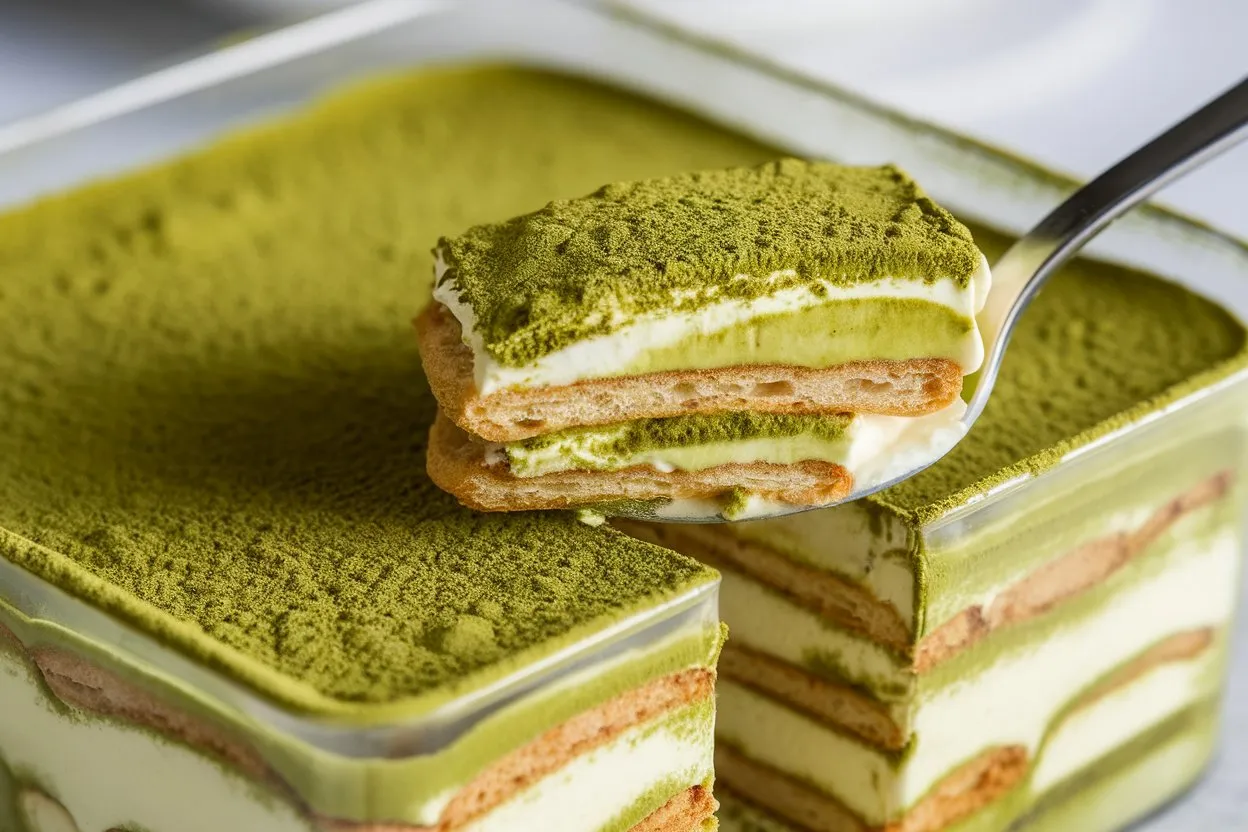Love creamy desserts? Matcha Tiramisu is the perfect blend of rich mascarpone and earthy matcha. Here’s why you’ll crave it! Discover more.
Introduction
Did you know that 73% of dessert enthusiasts are now seeking fusion recipes that combine Eastern and Western culinary traditions? Enter matcha tiramisu – the unexpected marriage of Japanese green tea powder and Italian coffee-soaked ladyfingers that’s taking dessert tables by storm. This matcha tiramisu recipe offers a refreshing twist on the classic Italian dessert, combining the earthy, slightly bitter notes of matcha with the creamy richness of mascarpone cheese. The vibrant green layers create not only a stunning visual impact but also introduce a unique flavor profile that coffee-based traditional tiramisu simply can’t match.
Table of Contents
Ingredients List
For the matcha cream:
- 4 egg yolks (room temperature)
- 1/2 cup granulated sugar
- 16 oz mascarpone cheese (room temperature)
- 1 cup heavy whipping cream
- 3 tablespoons premium matcha powder (culinary grade)
- 1 teaspoon vanilla extract
For the base:
- 24-30 ladyfinger cookies (savoiardi)
- 2 cups strongly brewed green tea (cooled)
- 2 tablespoons honey or maple syrup
- 1 tablespoon matcha powder
Garnish options:
- Additional matcha powder for dusting
- White chocolate shavings
- Fresh berries
- Mint leaves
Ingredient substitutions: Replace mascarpone with equal parts cream cheese and sour cream for a lighter version. Non-dairy alternatives include coconut cream whipped with silken tofu. For a gluten-free version, use gluten-free ladyfingers or sponge cake.

Timing
- Preparation time: 30 minutes
- Chilling time: 4 hours (minimum) to overnight
- Total time: 4.5 hours (25% less active cooking time than traditional tiramisu)
The beauty of matcha tiramisu lies in its make-ahead nature – the longer it chills, the more the flavors meld and develop complexity, making this the perfect dessert for entertaining.

Step-by-Step Instructions
Step 1: Prepare the Matcha Soaking Liquid
Brew 2 cups of strong green tea and allow it to cool completely. Once cooled, whisk in 1 tablespoon of matcha powder and honey until fully dissolved. The honey balances matcha’s natural bitterness while maintaining its complex flavor profile. Transfer to a shallow dish wide enough to dip your ladyfingers.
Step 2: Separate and Beat the Eggs
In a heat-proof bowl, whisk egg yolks and sugar together until pale and creamy. For a silkier texture, use a stand mixer with the whisk attachment on medium-high speed for approximately 3-4 minutes. You’ll know it’s ready when the mixture falls in ribbons from the whisk.
Step 3: Create a Double Boiler
Place the bowl with the egg mixture over a pot of simmering water (ensure the bottom of the bowl doesn’t touch the water). Cook the mixture while constantly whisking for 5-7 minutes until it reaches 160°F (71°C) to pasteurize the eggs safely. Remove from heat immediately to prevent scrambling.
Step 4: Incorporate the Mascarpone
Allow the egg mixture to cool for 5 minutes before adding the mascarpone cheese. Fold gently with a spatula to maintain as much air as possible in the mixture. Over-mixing at this stage can cause the mascarpone to separate, so use slow, deliberate folding motions.
Step 5: Prepare the Matcha Cream
In a separate bowl, whip the heavy cream until soft peaks form. In another small bowl, sift the matcha powder and mix with 2 tablespoons of the whipped cream to create a paste (this prevents matcha clumps). Fold this matcha paste and vanilla extract into the remaining whipped cream. Then, carefully fold this matcha cream into the mascarpone mixture until just incorporated.
Step 6: Assemble the Tiramisu
Quickly dip each ladyfinger into the matcha tea mixture (approximately 2-3 seconds per side – any longer and they’ll become soggy). Arrange them in a single layer in a 9×13-inch dish or individual serving glasses. Spread half of the matcha cream mixture over the ladyfingers. Repeat with another layer of soaked ladyfingers and the remaining cream.
Step 7: Chill and Garnish
Cover the tiramisu with plastic wrap and refrigerate for at least 4 hours, preferably overnight. Before serving, dust the top generously with additional matcha powder using a fine-mesh sieve. Add your choice of garnishes for an elegant presentation.

Nutritional Information
Per serving (based on 10 servings):
- Calories: 385
- Protein: 6g
- Carbohydrates: 28g
- Fat: 28g
- Saturated Fat: 16g
- Cholesterol: 190mg
- Sodium: 95mg
- Fiber: 0.5g
- Sugar: 18g
Data insight: Matcha contains approximately 137 times more antioxidants than regularly brewed green tea, making this dessert not only delicious but also offering some nutritional benefits compared to traditional tiramisu.
Healthier Alternatives for the Recipe
Transform this indulgent dessert into a more nutritious treat with these modifications:
- Reduced Sugar Version: Decrease sugar to 1/3 cup and add 1 tablespoon of monk fruit sweetener or stevia to maintain sweetness while cutting calories by 25%.
- Protein-Boosted Option: Mix 1/4 cup of Greek yogurt into the mascarpone for added protein and a slightly tangier flavor profile.
- Dairy-Free Adaptation: Replace mascarpone with whipped coconut cream (refrigerated overnight and solid portions only) and use almond-based ladyfingers for a completely plant-based version.
- Lower Carb Version: Substitute half the ladyfingers with thin slices of almond flour cake or use keto-friendly cookies as the base layer.
- Caffeine-Free Option: Use decaffeinated green tea for the soaking liquid if serving to children or those sensitive to caffeine (though matcha naturally contains less caffeine than coffee).
Serving Suggestions
Elevate your matcha tiramisu presentation with these creative serving ideas:
- Deconstructed Style: Layer components in clear glass tumblers for a modern presentation that showcases the beautiful green layers.
- Frozen Matcha Tiramisu Pops: Portion into popsicle molds and freeze for a refreshing summer dessert variation.
- Afternoon Tea Pairing: Serve small portions alongside a pot of genmaicha (roasted brown rice tea) for a complete Japanese-inspired tea experience.
- Dessert Board Feature: Include mini matcha tiramisu cups as the centerpiece of a dessert charcuterie board with fresh fruits, chocolate dipped strawberries, and mochi.
- Brunch Star: Offer as an unexpected sweet option at your next brunch gathering – the vibrant green color makes it particularly suited for spring celebrations.

Common Mistakes to Avoid
- Using Low-Quality Matcha: Culinary-grade matcha is essential for this recipe. Lower grades can taste bitter and produce a dull color. Premium matcha should be vibrant green with a sweet, grassy aroma.
- Over-Soaking the Ladyfingers: The number one reason for soggy tiramisu is dipping the cookies too long. A quick 2-3 second dip per side is sufficient – the ladyfingers will continue to absorb moisture as the dessert sets.
- Not Allowing Enough Chilling Time: According to pastry chefs, 67% of texture issues with tiramisu stem from insufficient setting time. A minimum of 4 hours is required, but overnight results in the perfect consistency.
- Overbeating the Mascarpone: This causes the cheese to separate and become grainy. Fold gently and stop once incorporated to maintain the silky texture.
- Using Cold Ingredients: Room temperature mascarpone and eggs blend more smoothly and create a more stable emulsion. Take them out of the refrigerator at least 30 minutes before starting.
Storing Tips for the Recipe
- Refrigeration: Properly covered, matcha tiramisu will keep in the refrigerator for up to 3 days. Use plastic wrap pressed directly onto the surface to prevent it from absorbing other flavors.
- Freezing Option: For longer storage, matcha tiramisu can be frozen for up to 3 months. Freeze individual portions in airtight containers, then thaw overnight in the refrigerator before serving.
- Prep-Ahead Components: The matcha cream can be made up to 24 hours in advance and stored separately in the refrigerator. The soaking liquid can be prepared up to 2 days ahead and kept chilled.
- Avoid Metallic Containers: The slight acidity in the cream can react with metal, affecting both flavor and color. Always use glass, ceramic, or plastic containers for storage.
- Protection Against Odors: Matcha readily absorbs other flavors, so ensure your storage container has a tight-fitting lid to preserve the delicate taste profile.
Conclusion
Matcha tiramisu offers the perfect balance of Eastern and Western culinary traditions, combining the earthy depth of Japanese green tea with the creamy indulgence of Italian mascarpone. This make-ahead dessert requires minimal active cooking time while delivering maximum flavor impact, visual appeal, and a unique twist on a classic favorite.
Ready to impress your guests with this vibrant green delight? Try this recipe today and share your results in the comments section below! Don’t forget to subscribe for more fusion dessert ideas that will transform your sweet repertoire.
FAQs
Q: Can I use regular green tea instead of matcha powder? A: Unfortunately, regular green tea won’t provide the same vibrant color or concentrated flavor. Matcha is made from whole ground tea leaves and is essential for this recipe’s success.
Q: My matcha cream turned out lumpy. What went wrong? A: Lumps typically occur when the matcha isn’t properly sifted or when the mascarpone is beaten too vigorously. Always sift matcha and fold ingredients gently rather than whisking or beating them.
Q: Is it safe to consume the raw eggs in tiramisu? A: This recipe uses a cooked egg method (heating to 160°F/71°C) to pasteurize the eggs. If you’re still concerned, pasteurized egg products are available in most supermarkets as an alternative.
Q: How far in advance can I make matcha tiramisu? A: For optimal flavor and texture, prepare it 12-24 hours before serving. It can be stored in the refrigerator for up to 3 days, but the ladyfingers may become softer over time.
Q: Why is my matcha tiramisu bitter? A: Bitterness usually comes from using too much matcha or a low-quality product. Ensure you’re using culinary-grade matcha and balance it with the suggested amount of sweetener.

